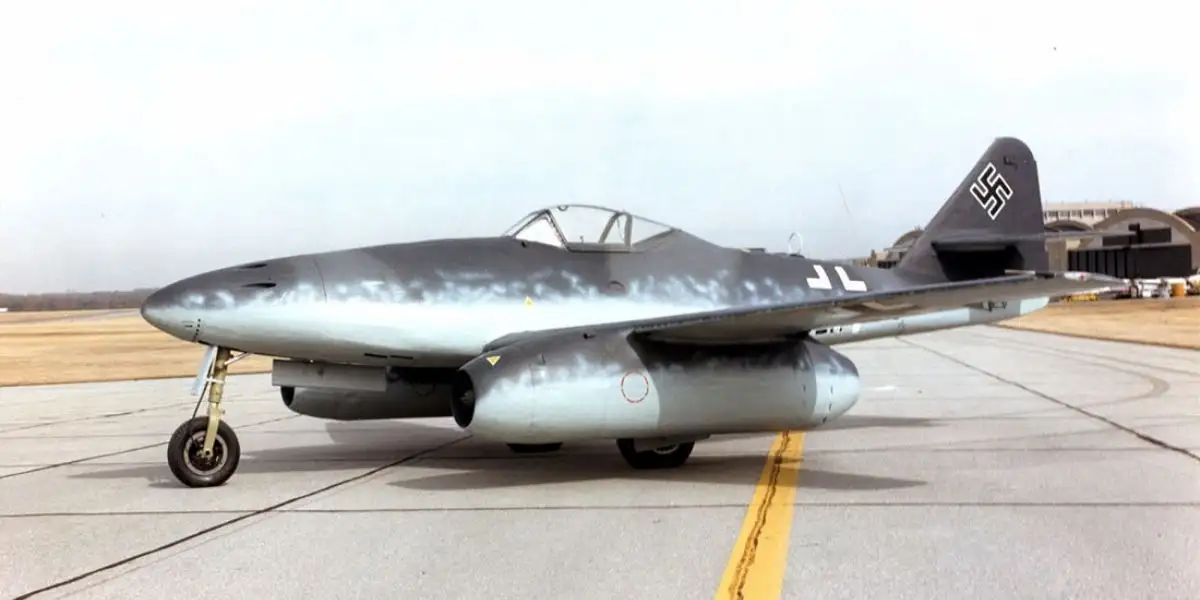Me 262 Schwalbe
The Me 262 Schwalbe, the first turbojet aircraft in the world to fly, was created from a 1938 Messerschmitt company design. When it was first flown on July 18, 1942, under jet power, it outperformed traditional aircraft in speed. Development issues (especially its temperamental engines), Allied bombings, and cautious Luftwaffe leadership all played a part in the manufacturing delays.
The Me 262 was the first jet aircraft to be employed in combat, attacking a British photo-reconnaissance Mosquito above Munich on July 25, 1944. As a fighter, the German jet scored heavily against Allied bomber formations.
The war against the jets intensifies
The war against the jets intensified in November as the Luftwaffe increased its sortie rate with the Me 262. Oberfahnrich Willi Banahaff of 3./ Kommando Nowotny was forced to bail out after an encounter with P-51s over Holland on the first day of the month, while 24 hours later there was some cheer when Feldwebel Erich Buttner shot down a P-51 and a P-47. However, this event was tempered by the loss of three more jets to Mustangs on Nov. 4.
In his book Me 262 Units in Combat, Robert Forsyth explains how Generalmajor Adolf Galland, the General der Jagdflieger, arrived at Achmer on November 7 for an inspection. Galland was already worried about the growing losses being suffered by his only jet fighter unit. The Kommando managed to send out only four jets in two missions against the bombers the following day as the USAAF bombed Nordhorn Canal and the marshaling yards at Rheine.
There was an inauspicious beginning when Walter Nowotny found that he was unable to start his aircraft for the first mission in the morning, while another machine suffered a burst tire. In the second mission that afternoon, Nowotny finally took off to engage the enemy. During his subsequent encounter, he shot down a four-engined bomber and a P-51, but as he returned home, he was apparently intercepted by an American fighter. A short while later, Nowotny’s crackling voice was heard over the radio.
The death of Luftwaffe Super Ace Walter Nowotny
‘We stepped into the open’, Galland later wrote. ‘Visibility was not good—six-tenths cloud. Seconds later, an Me 262 appeared out of the cloud and dived vertically into the ground. There was black smoke and an explosion’. Nowotny’s last words, though garbled, indicated that his aircraft was hit and on fire, and seconds later he crashed to his death.

The death of Major Walter Nowotny (An Austrian recipient of the highest award to the Knight’s Cross, the Diamonds, he had been credited with 255 victories while flying with I./JG 54 in the Soviet Union) effectively marked the end of the Kommando that bore his name, and it had not been a particularly glorious chapter in the history of the Me 262. Of around 30 Me 262s delivered to the unit, 26 are known to have been lost for one reason or another, the greater part through combat or indirectly as a result of combat or, equally worryingly, because of take-off or landing accidents and malfunctions.
However, Nowotny’s name, together with the aircraft that his unit had flown, would re-emerge as the honor title adopted by a much larger, more structured interceptor unit over the forthcoming weeks.
Me 262 Units in Combat is published by Osprey Publishing is available to order here.

Photo by U.S. Air Force

